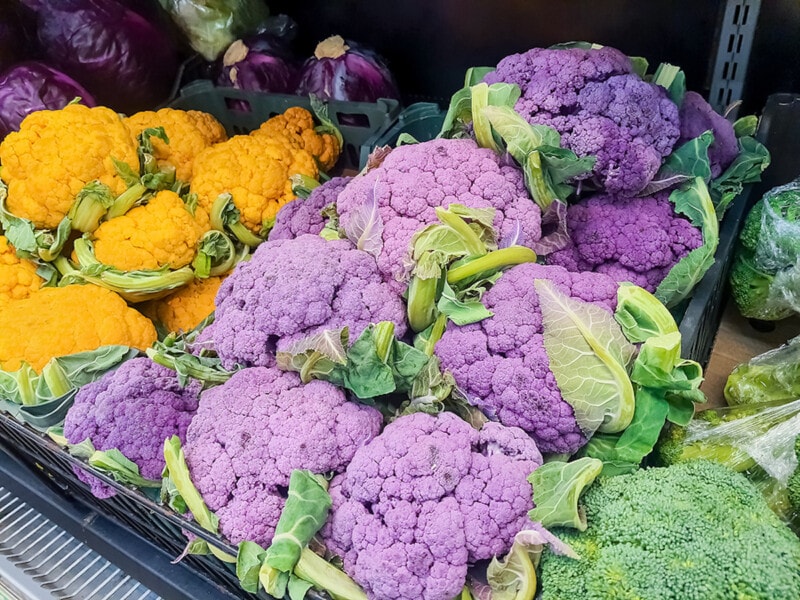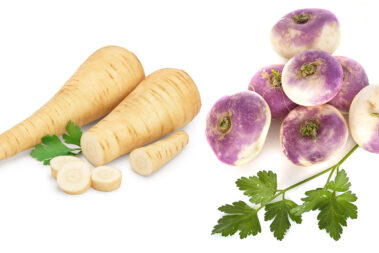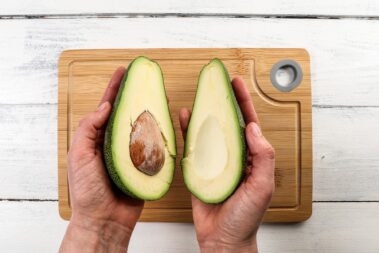If you think of cauliflower only as a white compact ball with pale green leaves, you’re missing out. Why? Because there are hundreds of different varieties of this vegetable!
Here are 15 of our favorite different types of cauliflower and how to best utilize each of them in your cooking.
Table of Contents
Types of Cauliflower
Cauliflower belongs to the same plant species as broccoli, cabbage, kale, Brussels sprouts, and collard greens. Each of these vegetables has been selectively bred for different qualities.
Cauliflower is prized for its large, edible, curd-like head and has been consumed by humans for at least two thousand years. In that time, humans have cultivated a wide variety of different types of cauliflower.
Let us introduce you to a few of our favorites.
Alverda
The alverda cauliflower has a unique lime green color that can be intensified with direct sun exposure. The heads are medium-sized and rimmed with gorgeous deep green leaves.
Unlike white varieties that tend to be crumbly, green cauliflower like alverda have a more fibrous consistency and a sweeter flavor. These green florets pair well with spicy curries and are a treat to eat raw. You can also use them in place of broccoli in many recipes to add a slightly different texture twist to tired dishes.
Attribute Hybrid
The attribute hybrid variety of cauliflower has been around for a long time and has a look similar to the type found in most grocery stores. The large, white head grows up to 7 inches in diameter and is protected by tall, jade-colored leaves.
In the garden, this two-foot-tall cauliflower variety provides a splash of muted blue-green that attracts the eye. In the kitchen, it has a buttery flavor with slightly nutty undertones. The large head lends itself well to grilling while the more neutral-flavored curds are perfect for making cauliflower rice. Try it in our Cauliflower Rice Stuffed Peppers.
Cheddar Hybrid

With a beautiful yellow-orange head and mild flavor, cheddar hybrid cauliflower is a popular choice for consumers who don’t necessarily like the taste of traditional cauliflower. It has a medium to large head with short, light yellow-green leaves.
Cheddar hybrid has a mild, sweet taste and smooth texture. It makes a great addition to Indian dishes and other savory meals that benefit from a slightly-sweet twist. The cheddar cheese color deepens during cooking, making this variety perfect for visually livening up your dinner plate, especially for something you want to have a cheesy look, like our Cheesy Vegan Roasted Cauliflower.
Like other orange varieties, cheddar hybrid is high in beta-carotene. It is also unusually high in vitamin A compared to other types.
Depurple Hybrid
With deep lavender heads and striking white stems, depurple hybrid cauliflower provide a brilliant color splash for any meal. It has a large, 7-inch head and muted blue to green leaves.
Depurple has a noticeably delicate texture and a pleasing buttery, yet sweet flavor. The color will fade some when exposed to heat, but adding lemon juice or vinegar to the florets before cooking will help preserve that violet pizzazz.
The purple hue of this cauliflower comes from anthocyanins, a flavonoid with powerful antioxidant effects. This is the same compound that gives red wine some of its fantastic health benefits, so eat up!
Early White Hybrid
What early white hybrid cauliflower lacks in pigment, it makes up for in size and versatility. The extra-large head grows to 9 inches while the plant itself can reach an impressive 30 inches tall.
The compact head is pure white with serrated jade leaves that hug the curd throughout growth. With more of a traditional cauliflower taste, this variety is perfect for grilling, roasting, sauteing, and crumbling into rice. It also holds up surprisingly well in the freezer.
Fioretto Cauliflower

Fioretto is a true-breeding hybrid of white cauliflower and broccoli. It has long, thin, light green stems with small, yellow-white bud clusters on the ends. It goes by many names, including Chinese cauliflower and flowering cauliflower.
Strange looking as it may be, this veggie is truly a delicacy. It has a uniquely sweet yet nutty flavor and retains a crunchy texture even after cooking. It is delicious when roasted with some garlic, parmesan, or spices and the perfect addition to Chinese dishes like stir fry.
Flame Star Hybrid
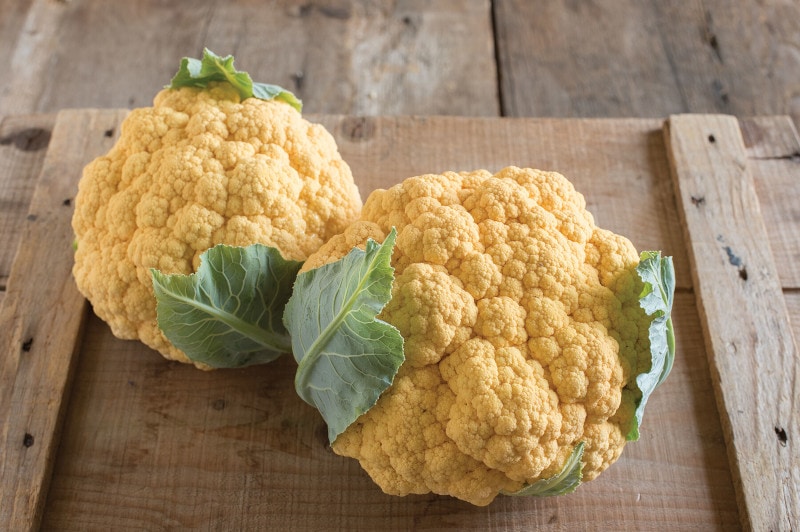
The pastel-orange flame star hybrid has a similar look and characteristics to the cheddar hybrid, but with a slightly different flavor. This type has a large head but only grows to about a foot tall.
The brilliant orange color deepens when this veggie is exposed to heat. With a simple buttery, nutty flavor, the flame star performs well in a variety of dishes. Between the eye-catching color and smooth texture, this is one of our favorite cauliflower varieties to include on raw veggie trays.
Graffiti Hybrid
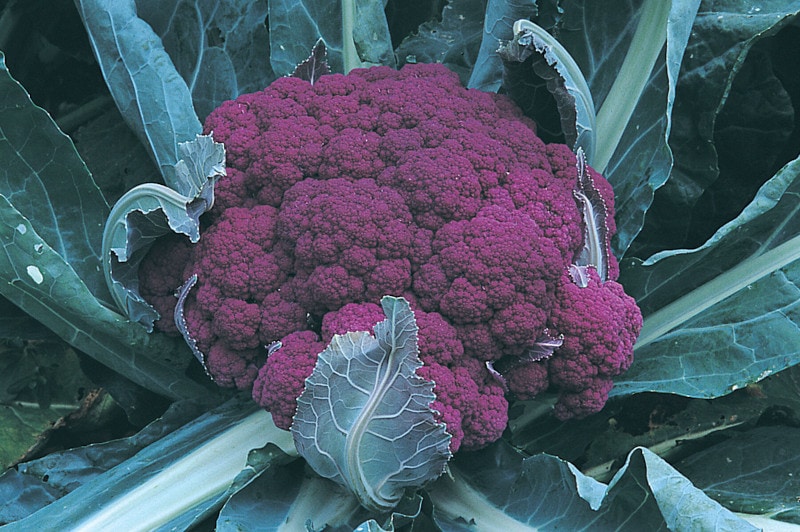
Graffiti hybrid cauliflower is one of the most vibrant varieties. The deep purple head can be dark lavender or slightly more plum.
The dense heads of the graffiti hybrid have a slightly sweet, mild taste. The florets retain their impressive color even when exposed to heat. We recommend steaming, sauteing, or a quick boil. For more intense cooking, try marinating in lemon juice or vinegar first to help preserve those deep hues and to retain more of the healthy anthocyanins.
Purple Cape
Another showstopper worth including in the garden and on your plate is the purple cape cauliflower. The head is a gorgeous lilac purple with a mix of light green and purple leaves snaking up the sides.
It is one of the sweetest purple varieties and has a taste more reminiscent of broccoli than its pale cousin. It is another great candidate for Indian dishes and raw veggie plates. It’s high in antioxidants, vitamin C and A, and, like all cauliflower, loaded with fiber.
Romanesco Cauliflower

Sometimes called romanesco broccoli, romanesco cauliflower has compact curds similar to the latter, green coloring similar to the former, and a spikey, geometric shape all its own. Since broccoli and cauliflower are the same species to begin with, either name is technically correct.
The whirling, spikey florets of the romanesco look like they belong on a geode, not in a salad. But don’t let the alien look throw you, this veggie has a deep earthy taste and crunchy texture. It is excellent baked with oil and spices, but can also be used in dishes to replace more common types of cauliflower.
Self-Blanching Snowball
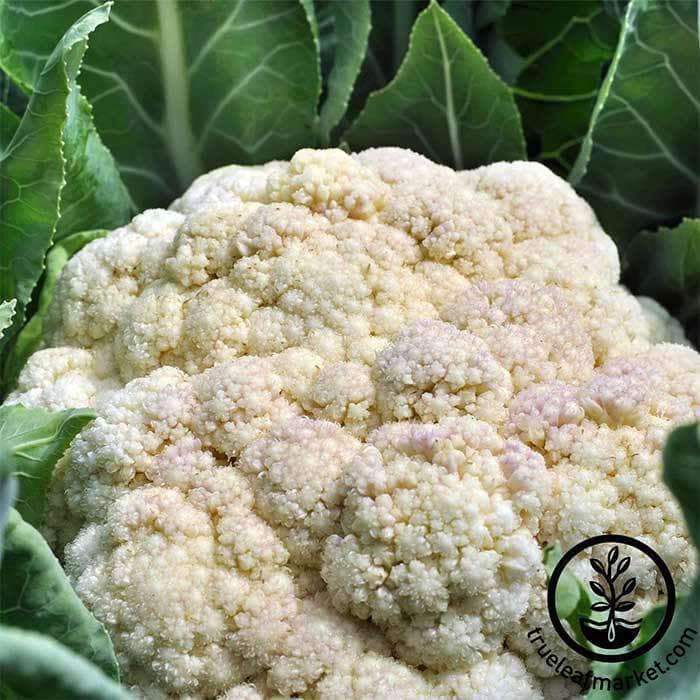
Self-blanching snowball is an heirloom variety very similar to the original cauliflower types cultivated by early societies. It has a large to extra large head and long blue-green leaves that curl over the curds if exposed to excessive heat or cold. This plant “behavior” is known as blanching.
This variety has a flavor profile more typical of the cauliflower sold in stores. The dense florets generally take on the spices of the dish, which makes it a great choice for spicy dishes like our Crispy Cauliflower Tacos. Snowball cauliflower is great for adding texture and fiber to any savory meal.
Sicilian Violet
Another heirloom variety–this one coming from Italy–the head of the Sicilian violet it tipped with plum to lavender hues with light green stalks. It is easy to grow and forms medium heads dressed with green leaves.
This beautiful cauliflower has a mild flavor that blends well with many dishes. When cooked, however, it loses that purple flair and morphs instead into a deep green. To preserve the beauty and the antioxidant benefits, we recommend slicing the florets thin and serving them raw with some roasted beet hummus.
Snowball Y
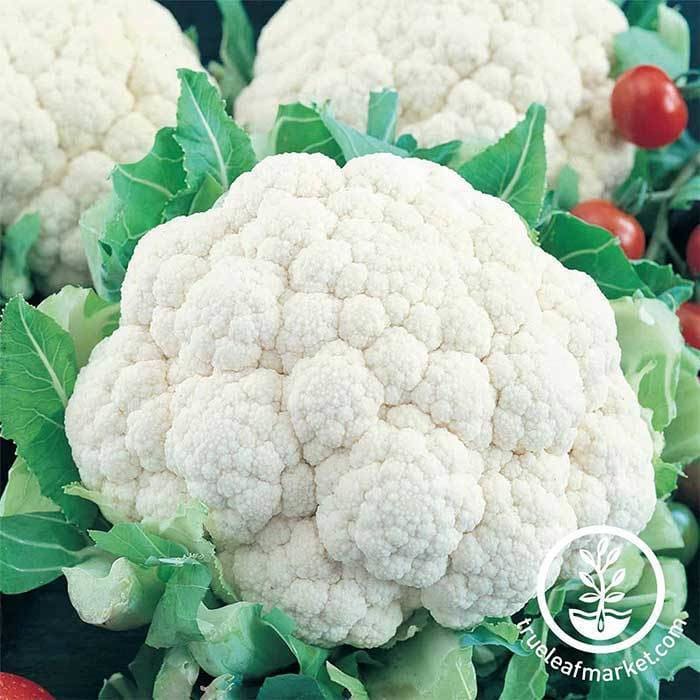
The snowball Y cauliflower is similar to other white varieties but has a notably smaller head. The curds are tightly compact and pure white while the surrounding leaves are a vibrant green.
The snowball Y makes for a delicious addition to any dish that would typically use cauliflower. It has a nutty flavor and smooth texture that also makes it a great choice for homemade cauliflower rice.
Violet Queen
The beautiful violet queen has a deep violet color that looks almost black in the right light. Like any good queen, this cauli is tough. It can withstand temperatures as low as 14 degrees.
The deep purple hues of this cauliflower don’t fade with heat and it can be enjoyed in a variety of different ways, including grilled, sauteed, and raw. The leaves of this queen are also edible and are especially delicious cooked up with some oil, salt, and pepper.
White Corona Hybrid
Sometimes less is more, and that is certainly the idea behind the cultivation of the white corona hybrid cauliflower. The dense white heads of this variety top out at 5 inches and can be grown easily in pots.
This little cauliflower packs a lot of taste into a small package. Buttery and nutty, these florets are perfect when matched with strong dips or sauces. We especially like this variety for making cauliflower steaks–the small heads are much easier to slice and prepare.
Grow Your Own Cauliflower
With so many adaptable varieties of cauliflower available, it is more than possible to grow your own cauli-patch in the backyard (or even on the patio!).
The key to success with most cauliflower varieties is sowing the seeds so that the plant matures when the weather is cool.
In hot climates, this usually means planting in fall so the crop can mature in early spring. In cooler climates, you’ll have to start seeds indoors to transplant in spring. Or, sow seeds directly in summer for a fall crop.
In any case, you’ll need to find a type that matures fast enough or slow enough to reach full size at the right time. White corona hybrid, the fastest-growing cauli, will begin producing florets after just a month and a half. Romanesco, on the other hand, can take up to four months to mature.
In addition to proper timing and cool weather, cauliflower also requires even watering, partial shade as the season heats up, and protection from pests.
Some varieties also require blanching to protect the curds from excessive heat and frost. Some types are self-blanching while others will require you to pull the leaves over the head and tie them loosely with twine until the florets mature.
Whether you decide to try your hand at growing this finicky veggie or just pick some up at the local farmer’s market, it is absolutely worth investigating this ancient crop a little more.
With so many different types of cauliflower available, you are sure to find one you love! Once you do, be sure to save yourself some prep time by checking out our article on how to cut cauliflower without making a mess.
FAQ
How many different types of cauliflower are there?
There are hundreds of different types of cauliflower. Each type represents a different cultivator—not separate species, but different “breeds” with slightly different characteristics. Crossing these cultivators creates yet more variety, which is why there are so many different types of cauliflower in the world.
Which cauliflower is healthiest?
Darkly pigmented cauliflower has the most health benefits because it contains the same amount of macronutrients as other types plus extra flavonoids and antioxidants.
Does green cauliflower taste different?
Yes, green cauliflower does taste a little different than white. In fact, all different color variations have a slightly different flavor. This is because the flavonoids that give them their color also give them unique flavors.
How do you pronounce cauliflower?
According to Merriam Webster, the correct pronunciation of cauliflower is:
“Kawl-luh-flaw-ur”
Still confused? Listen to the word being correctly pronounced here.
Cooking with Cauliflower
Whether you have regular old white cauliflower, a vibrant head of graffiti, or some gorgeous Romanesco, you have the key ingredient to make a variety of tasty meals. Here are some of our favorite cauliflower recipes.
- Cheesy Vegan Roasted Cauliflower – Roasted with nutritional yeast to vegan-cheesy perfection.
- Cauliflower Rice Stuffed Peppers – A delicious, low-carb version of the classic.
- Vegan Buffalo Cauliflower Wings – Breaded buffalo cauliflower that tastes just like the real thing.
- Crispy Cauliflower Tacos – Crispy and crunchy with a tasty chipotle sauce.
If you like these recipes, don’t forget to sign up for our newsletter. We’ll send more recipes like this plus great vegan tips straight to your inbox each week.
So Many Different Types of Cauliflower
With so many different cultivators of cauliflower to choose from it can be hard to decide what to grow in your garden and what to cook in your kitchen. We recommend starting with the varieties listed above and moving on from there.
What is your favorite type of cauliflower? Let us know in the comments section below.
- How to Pick the Perfect Watermelon For a Sweet Summer Treat - April 10, 2024
- Future Kind’s Foundations: A Multivitamin Made for Vegans - December 5, 2023
- Does Nutritional Yeast Go Bad? - November 28, 2023

